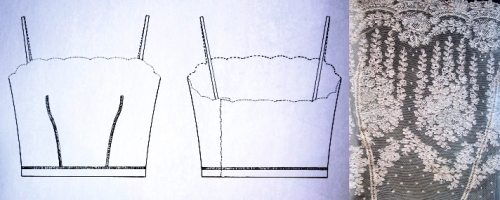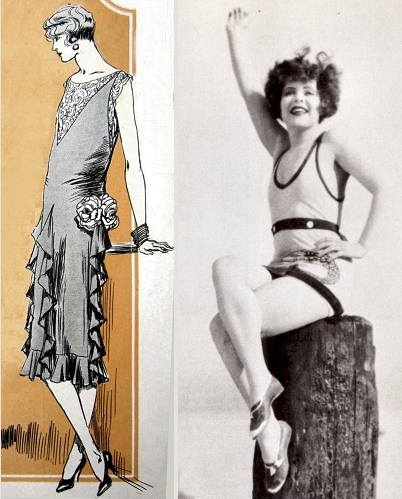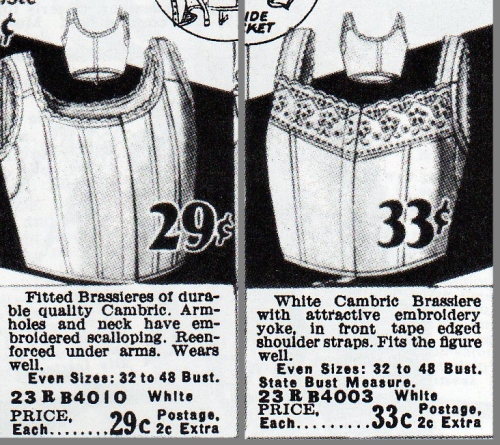The women’s undergarment called a “brassière” has been around since 1905 in the U.S. (1) and before 1912 in England (2). However, the first brassieres didn’t look anything like the garment we know today. (Numbers) indicate sources listed at end of post. [Read about 1920s Girdles and Corsets here. Read about Early 1920s Fashions here.]
A very similar brassiere, made entirely of delicate machine lace, is in the Victoria and Albert Museum.

Lace Bandeau Brassiere circa 1920, from Fashion in Detail. (4) Drawing by Leonie Davis, lace photograph by Richard Davis. It closes at the side back with hooks and eyes, so the help of a maid would be required to put it on.
An undergarment like this, worn very tightly, would compress the breasts. However, if I had found any of these brassieres in a box of vintage underwear, I might have classified them as camisoles, rather than brassieres.
The first uplift brassieres — with shoulder straps and a snug, elasticized band below the breasts, and, most importantly, two distinct cups for the breasts — were not mass-produced until the mid-to-late nineteen twenties.
Ideal Fashion Figure, Early 1920s
Movie star Clara Bow had an ideal figure for early 1920s fashions; she epitomized the garçonne, or “boy-girl” look.
Naturally, most of the women alive in the twenties did not look like boys at all.
And this is where the brassieres, bandeaux, and bust flatteners come in.
Bust-flattening Bandeaux and Brassieres, 1920s

Ads for De Bevoise Bandeaux, May & April 1925. Both are made of stiff corset material; the one on the right is boned and designed to flatten a more mature figure.
The terms brassiere and bandeau were not used consistently, but in general a 1920s “bandeau” was a band that went around the chest, supported by two ribbon straps.
A “brassiere” was less skimpy and usually reached to the waist; both brassieres and bandeaux had one or more tabs that could be used to attach them to the girdle or a waist-high corset, which in turn had suspended garter hooks which attached to the stockings.
You can see that, although the brassieres above resemble the brassieres from 1917 pictured at the top of this post, there is a difference: these 1920s brassieres have almost no curve. They are meant to flatten the bust.

Bust flattening brassieres for “stout women” from a Sears catalog, 1928-29. From Everyday Fashions of the Twenties, p. 130.
The brassiere on the left is “for stout women and nursing mothers” [Ouch!] only because it fastens up the front.
Reducing Brassieres
Women who were not content with compressing their breasts could try to reduce them:
Madame X corsets, girdles, and brassieres were also made of rubber, and usually worn over an absorbent undergarment. The purpose of the rubber was to “sweat off” the fat.
Brassieres That Hold Your Stockings Up (and Push Your Breasts Down)

Brassieres from 1928-29. Pictured in Everyday Fashions of the Twenties. The brassiere on the left is unboned and “comfortable for sports or dancing.” The one on the right “can be worn without a corset.”
Even in the twenties, some objected to bust-flatteners on the grounds that they would damage breast tissue. These garter-and-brassiere combinations, with the stockings exerting a constant downward pull, must have forced all but the smallest breasts to crease at the bottom. In addition to breaking down the breast tissue, imagine how perspiration forming in those creases would have caused rashes and general misery in warm weather.
Bandeaux and the Boyshform Binder
These 1928 bandeaux have elastic backs, and either a back or side closing. Notice that they have some easing along the side seam, but they still have the “uni-bosom” or “mono-bosom” look of the previous century, as if a woman had one, large, oblong breast running across her chest. These bandeaux were intended to make even that slight curve disappear.
I have not yet come across a picture of the Boyshform binder. The Boyshform company was formed about 1918 and “claimed optimistically that its utterly flat bandeaux would hold the bust in position without ‘pressure or pinching.’ ” (1) Another bust flattener with a punning name was the Kabo Corset Company’s “Flatter-U.” The bust reducer illustrated below has a back made from corset material and a front made from several overlapping bands of elastic stitched together:

“Elastic Front Brassiere Bust Reducer gives the figure firm lines. Corset material back….” 1928. Pictured in Everyday Fashions of the Twenties.
The authors of Uplift: The Bra in America suggest that the Maiden Form company trademarked that name in 1924 to distinguish the purpose of its new, non-flattening bras from the Boyshform flatteners.
Corselets, Corsolettes, Corselettes, Corsettes and Other Combination Undergarments
The discomfort of brassieres that had to be buttoned with a tab to corsets or girdles — and probably often produced a bulge at the waist where the gap occurred — led to the widespread adoption of a combination garment that was called (with several spelling variations) the corselette.

1924 Brassiere Corset combination, 1924 Long Brassiere; 1925 Treo Brassiere Girdle Combination Garment Ad. All from Delineator magazines.
Treo undergarments, here pictured from an ad in Delineator magazine, were sold in stores and also carried as a brand name in the Sears, Roebuck catalog, so they reached a wide spectrum of customers. (1)

1925 Ad for Bien Jolie Step-In Corsette; “which comfortably flattens the lines of the body.” Delineator.
Women could also make their own simple — and flattening — brassieres, bandeaux, and corselettes from sewing patterns until true uplift bras, which “lifted and separated,” became available in the mid-1920s, and were too complex for the home stitcher. Simple bandeaux which had cups, but did not give support, were still featured in pattern catalogs.
The End of the Boyish Form
Breast flatteners and binders continued to be sold throughout the 1920s, but the return to a more natural, feminine figure in the second half of the twenties — accompanied by the invention of brassieres that had cups that fit and actually supported the breasts — gradually put an end to bust flatteners. The Boyshform company was in financial trouble by August of 1925 and went bankrupt in 1928. (1)
Sources especially useful for this post include (1) Uplift: The Bra in America, by Jane Farrell-Beck and Colleen Gau; (2) Fashion in Underwear: From Babylon to Bikini Briefs, by Elizabeth Ewing; (3) Everyday Fashions of the Twenties as Pictured in Sears and Other Catalogs, by Stella Blum; (4) Women’s and Children’s Fashions of 1917: The Complete Perry, Dame & Co. Catalog, a Dover Book; (5) Fashion in Detail: Underwear, (V&A Museum), by Eleri Lynn, Photographs by Richard Davis, Drawings by Leonie Davis; (6) The Mode in Costume, by Ruth Turner Wilcox, (7) Fashion, by Mila Contini; (8) History of Twentieth Century Fashion, by Elizabeth Ewing, (9) 20,000 Years of Fashion, by Francois Boucher, and issues of Delineator magazine from 1924 to 1929.











